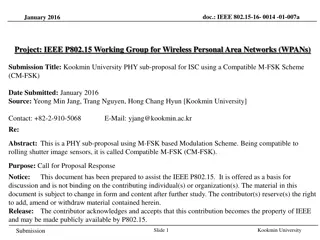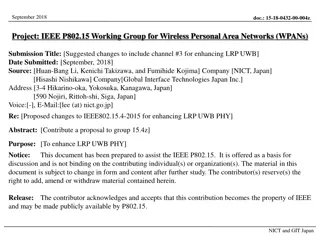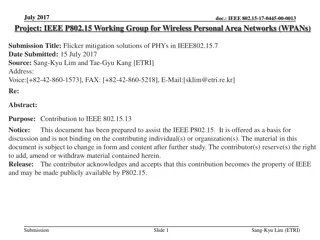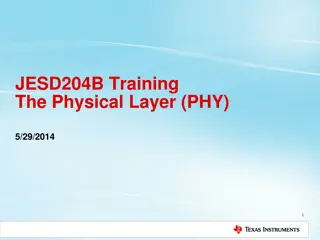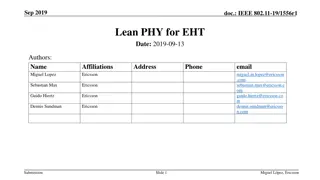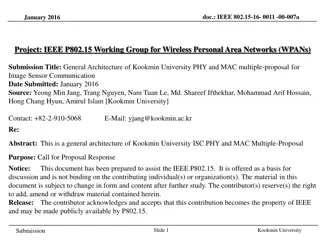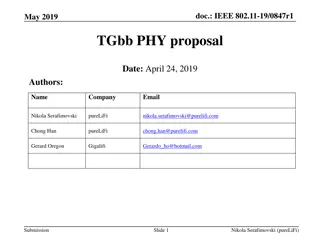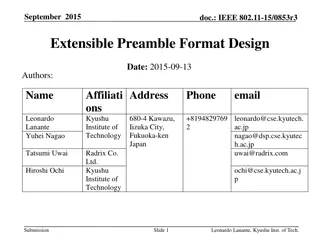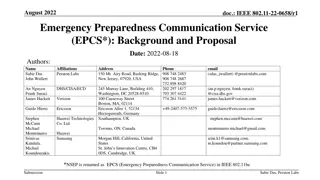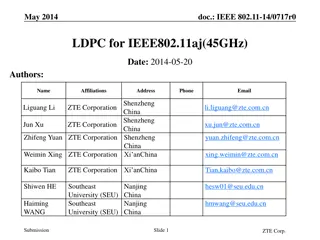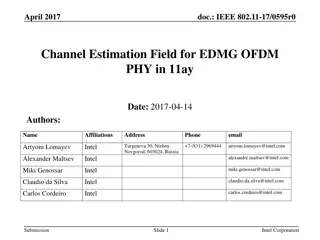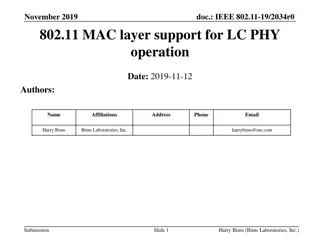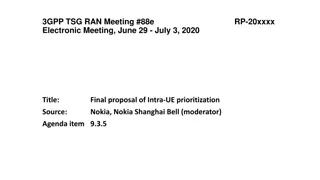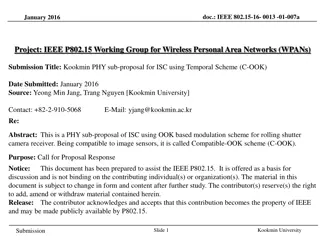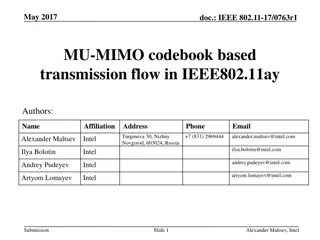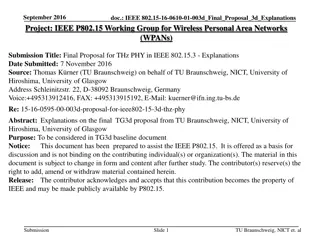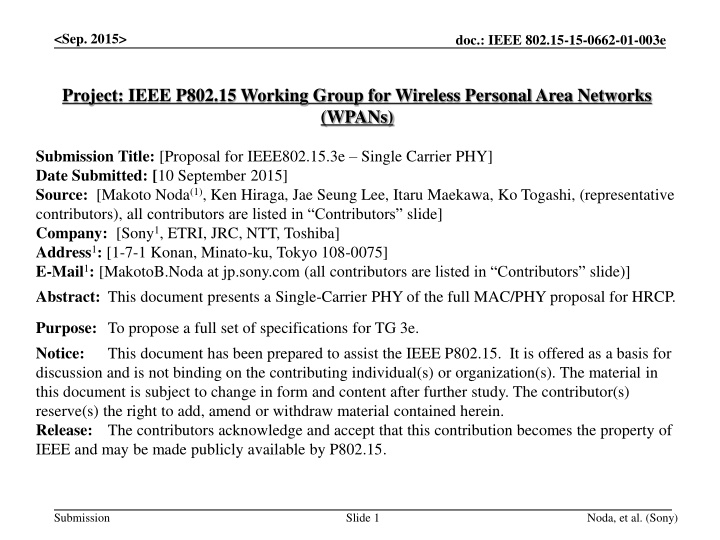
IEEE 802.15.3e Single Carrier PHY Proposal for High-Rate Close Proximity System
Explore the detailed submission by Sony and other contributors to the IEEE P802.15 Working Group for Wireless Personal Area Networks. The proposal outlines a Single Carrier PHY for HRCP with extremely high PHY-SAP payload bit rates, offering significant improvements over existing standards. It includes specifications for TG 3e and covers topics like channelization, modulation, coding, frame format, preamble, and MCS evaluation. The document aims to foster discussion and is not binding, subject to potential revisions.
Download Presentation

Please find below an Image/Link to download the presentation.
The content on the website is provided AS IS for your information and personal use only. It may not be sold, licensed, or shared on other websites without obtaining consent from the author. If you encounter any issues during the download, it is possible that the publisher has removed the file from their server.
You are allowed to download the files provided on this website for personal or commercial use, subject to the condition that they are used lawfully. All files are the property of their respective owners.
The content on the website is provided AS IS for your information and personal use only. It may not be sold, licensed, or shared on other websites without obtaining consent from the author.
E N D
Presentation Transcript
<Sep. 2015> doc.: IEEE 802.15-15-0662-01-003e Project: IEEE P802.15 Working Group for Wireless Personal Area Networks (WPANs) Submission Title: [Proposal for IEEE802.15.3e Single Carrier PHY] Date Submitted: [10 September 2015] Source: [Makoto Noda(1), Ken Hiraga, Jae Seung Lee, Itaru Maekawa, Ko Togashi, (representative contributors), all contributors are listed in Contributors slide] Company: [Sony1, ETRI, JRC, NTT, Toshiba] Address1: [1-7-1 Konan, Minato-ku, Tokyo 108-0075] E-Mail1: [MakotoB.Noda at jp.sony.com (all contributors are listed in Contributors slide)] Abstract: This document presents a Single-Carrier PHY of the full MAC/PHY proposal for HRCP. Purpose: To propose a full set of specifications for TG 3e. Notice: This document has been prepared to assist the IEEE P802.15. It is offered as a basis for discussion and is not binding on the contributing individual(s) or organization(s). The material in this document is subject to change in form and content after further study. The contributor(s) reserve(s) the right to add, amend or withdraw material contained herein. Release: The contributors acknowledge and accept that this contribution becomes the property of IEEE and may be made publicly available by P802.15. Submission Slide 1 Noda, et al. (Sony)
<Sep. 2015> doc.: IEEE 802.15-15-0662-01-003e Contributors Name Affiliation Email Jae Seung Lee ETRI jasonlee@etri.re.kr Moon-Sik Lee ETRI moonsiklee@etri.re.kr Itaru Maekawa Japan Radio Corporation maekawa.itaru@jrc.co.jp Lee Doohwan NTT Corporation lee.doohwan@lab.ntt.co.jp Ken Hiraga NTT Corporation hiraga.ken@lab.ntt.co.jp Masashi Shimizu NTT Corporation masashi.shimizu@upr-net.co.jp Keitarou Kondou Sony Corporation Keitarou.Kondou at jp.sony.com Hiroyuki Matsumura Sony Corporation Hiroyuki.Matsumura at jp.sony.com Makoto Noda Sony Corporation MakotoB.Noda at jp.sony.com Masashi Shinagawa Sony Corporation Masashi.Shinagawa at jp.sony.com Ko Togashi Toshiba Corporation ko.togashi@toshiba.co.jp Kiyoshi Toshimitsu Toshiba Corporation kiyoshi.toshimitsu@toshiba.co.jp Submission Slide 2 Noda, et al. (Sony)
<Sep. 2015> doc.: IEEE 802.15-15-0662-01-003e Proposal for IEEE802.15.3e High-Rate Close Proximity System September 10, 2015 Submission Slide 3 Noda, et al. (Sony)
<Sep. 2015> doc.: IEEE 802.15-15-0662-01-003e Single Carrier (SC) PHY Extremely high PHY-SAP payload-bit rates outperforming those of 15.3c Min. 2 Gb/s and Max. 13 Gb/s, using a single channel with 2.16 GHz bandwidth Reusing the best error-correction code respecting 15.3c Reusing the rate-14/15 low-density parity-check (LDPC) code Introducing a new rate-11/15 LDPC code whose decoder compatible with that for the rate-14/15 LDPC code to obtain moderate bit rates New preamble, comparing 15.3c: Decrease the length Double the zero-auto correlation zone of the channel-estimation sequence MIMO in SC PHY for 100 Gb/s is described in other material (15-0661/r1). SC PHY proposal is also described in a draft version (15-0665/r1). Submission Slide 4 Noda, et al. (Sony)
<Sep. 2015> doc.: IEEE 802.15-15-0662-01-003e Index for HRCP-SC PHY 1. Channelization of HRCP-SC PHY 2. Modulation and coding 3. Frame format 4. Preamble 5. MCS Evaluation Submission Slide 5 Noda, et al. (Sony)
<Sep. 2015> doc.: IEEE 802.15-15-0662-01-003e Index for HRCP-SC PHY 1. Channelization of HRCP-SC PHY 2. Modulation and coding 3. Frame format 4. Preamble 5. MCS Evaluation Submission Slide 6 Noda, et al. (Sony)
<Sep. 2015> doc.: IEEE 802.15-15-0662-01-003e Channel assignments for a single channel CHNL_ID Start Center frequency Stop frequencya frequencya 1 57.240 58.320 59.400 2 59.400 60.480 61.560 3 61.560 62.640 63.720 4 63.720 64.800 65.880 a The start and stop frequencies are nominal values. The frequency spectrum of the transmitted signal needs to conform to the transmit spectral mask as well as any regulatory requirement. Submission Slide 7 Noda, et al. (Sony)
<Sep. 2015> doc.: IEEE 802.15-15-0662-01-003e Transmit spectral mask for a single channel (same as that in 802.11ad) Power (dB) 0 (0.94, 0) ( 0.94, 0) 10 ( 1.2, 17) (1.2, 17) 20 (2.7, 22) ( 2.7, 22) (3.06, 30) ( 3.06, 30) 30 1 2 3 3 1 0 2 (f fc) (GHz) Submission Slide 8 Noda, et al. (Sony)
<Sep. 2015> doc.: IEEE 802.15-15-0662-01-003e Index for HRCP-SC PHY 1. Channelization of HRCP-SC PHY 2. Modulation and coding 3. Frame format 4. Preamble 5. MCS Evaluation Submission Slide 9 Noda, et al. (Sony)
<Sep. 2015> doc.: IEEE 802.15-15-0662-01-003e Modulation and coding scheme (MCS) Minimum 2 Gb/s and Maximum 13 Gb/s MCSs using a single channel MCS identifier single-carrier modulation FEC Rate PHY-SAP payload-bit rate (Gb/s) w/o PW w/ PW 0 /2 QPSK 11/15 2.5813 2.2587 1 /2 QPSK 14/15 3.2853 2.8747 2 16QAM 11/15 5.1627 4.5173 3 16QAM 14/15 6.5707 5.7493 4 64QAM 11/15 7.7440 6.7760 5 64QAM 14/15 9.8560 8.6240 6 256QAM 14/15 13.1413 11.4987 PW: pilot word PW length/sub-block length = 0.125 Submission Slide 10 Noda, et al. (Sony)
<Sep. 2015> doc.: IEEE 802.15-15-0662-01-003e Forward Error Correction Reuse the 14/15 LDPC code and a new 11/15 LDPC code with the best code efficiencies. Gap between SNRr* obtained by floating point simulation and the Shannon limit in binary AWGN channel for codes employed in standards. Shannon limit code standard rate SNRr gap (dB) (dB) (dB) RS(240,224) on GF(28) T J 0.933 9.77 6.51 3.26 rate 14/15 LDPC(1440,1344) 15.3c 0.933 8.46 6.51 1.96 LDPC(672,588) 15.3c 0.875 7.55 5.27 2.28 LDPC(672,546) 11ad 0.813 6.96 4.26 2.70 LDPC(672,504) 11ad 0.750 5.91 3.39 2.53 rate 11/15 LDPC(1440,1056) New 0.733 5.36 3.17 2.20 SNRr*: signal-to-noise ratio required for a bit-error rate of 10 6 Submission Slide 11 Noda, et al. (Sony)
<Sep. 2015> doc.: IEEE 802.15-15-0662-01-003e Proposed Overlaid-rate-compatible (ORC) LDPC Codes A check matrix of a high-rate code composed of overlay of sub-matrices in a check matrix of a low-rate code. This structure enables to share a belief-propagation decoder for the high-rate and low-rate LDPC codes. 1 0 0 0 0 0 0 0 1 0 0 0 0 0 0 0 1 0 0 0 0 0 0 0 1 0 0 0 0 0 0 0 1 0 0 0 0 0 0 0 1 0 0 0 0 0 0 0 1 0 0 0 0 1 0 0 0 0 0 0 0 1 0 0 0 0 0 0 0 1 1 0 0 0 0 0 0 0 1 0 0 0 0 0 0 0 1 0 0 0 0 0 0 0 1 0 0 0 0 0 0 0 0 0 1 1 0 0 0 0 0 0 0 1 0 0 0 0 0 0 0 1 0 0 0 0 0 0 0 1 0 0 0 0 0 0 0 1 0 0 0 0 0 0 0 1 0 0 0 0 0 0 1 0 0 0 0 0 0 0 1 1 0 0 0 0 0 0 0 1 0 0 0 0 0 0 0 1 0 0 0 0 0 0 0 1 0 0 0 0 0 0 0 1 0 0 0 0 0 0 0 0 1 1 0 0 0 0 0 0 0 1 0 0 0 0 0 0 0 1 0 0 0 0 0 0 0 1 0 0 0 0 0 0 0 1 0 0 0 0 0 0 0 1 0 1 0 0 0 0 0 0 0 1 0 0 0 0 0 0 0 1 0 0 0 0 0 0 0 1 0 0 0 0 0 0 0 1 0 0 0 0 0 0 0 1 0 0 0 0 0 0 0 1 0 0 0 0 1 0 0 0 0 0 0 0 1 0 0 0 0 0 0 0 1 1 0 0 0 0 0 0 0 1 0 0 0 0 0 0 0 1 0 0 0 0 0 0 0 1 0 0 0 0 1 0 0 0 0 0 0 0 1 0 0 0 0 0 0 0 1 0 0 0 0 0 0 0 1 0 0 0 0 0 0 0 1 0 0 0 0 0 0 0 1 1 0 0 0 0 0 0 A low-rate parity-check matrix, as a simplified example of an 11/15 LDPC code 1 0 0 0 0 0 1 1 1 0 0 0 0 0 0 1 1 0 0 0 0 0 0 1 1 0 0 0 0 0 0 1 1 0 0 0 0 0 0 1 1 0 0 0 0 0 0 1 1 1 0 0 0 1 0 0 0 1 0 0 0 1 0 0 0 1 0 0 0 1 1 0 0 1 0 0 0 0 1 0 0 1 0 0 0 0 1 0 0 1 0 0 0 0 1 0 0 1 0 0 0 0 1 0 1 1 0 0 0 0 1 0 0 1 0 0 0 0 1 1 0 1 0 0 0 0 0 1 0 1 0 0 0 0 0 1 0 1 0 0 0 0 0 1 0 1 0 0 1 0 0 0 1 0 0 0 1 0 0 0 1 1 0 0 1 0 0 0 0 1 0 0 1 0 0 0 0 1 0 0 1 0 0 0 0 1 0 0 1 1 0 0 0 1 0 0 A high-rate parity-check matrix, as a simplified example of a 14/15 LDPC code Submission Slide 12 Noda, et al. (Sony)
<Sep. 2015> doc.: IEEE 802.15-15-0662-01-003e A Simple LDPC encoder A systematic (n, k) quasi-cyclic code, such that every cyclic shift of a codeword by p symbols yields another codeword, can be encoded by using p generator polynomials and an (v = n k+p 1)-stage shift register*. information bits information bits (for x0) (for x1) (for xv 1) parity bits + + + D D D 0 (Zero is selected after k information bits are received) Select a generator polynomial g(n i 1)modp*xp 1 {(n i 1)modp} at time i, where i = 0 is defined as the time that the first v information bits are stored in the v-stage shift registers; v = 96+15 1 = 110 for a rate-14/15 LDPC code and v = 96*4+15 1 = 398 for a rate-11/15 LDPC code. * H. Yamagishi and M. Noda, Proc. IEEE, pp.78-83, Sep. 2008 Submission Slide 13 Noda, et al. (Sony)
<Sep. 2015> Performance comparison of LDPC decoders doc.: IEEE 802.15-15-0662-01-003e A quasi-cyclic LDPC code with a regular structure simplifies the decoder Hung, 2010 [2] Coz, 2011 [3] Okada, 2013 [1] 1440 672 1944 codeword length (bits) 15.3c 15.3c 11n IEEE802 standard 6.45 5.79 0.693 max. user rate (Gb/s) 40nm LP 65nm LP SOI 65nm LP CMOS process 0.46 1.56 2 core area (mm2) supply voltage (V) 1.1 1.0 1.2 operation frequency (MHz) 288 197 360 power at BER = 10 6 (mW) 76 361 288 1/5 1/35 energy efficiency (pJ/bit) 11.8 62.4 416 error floor at BER = 10 11 none not confirmed not confirmed chip configuration all BB LDPC only LDPC only [1] K. Okada, et al., IEEE J. Solid State Circuits, vol. 48, no.1, pp. 46-65, Jan. 2013 [2] S-Y. Hung, et al., Proc. IEEE (ASSCC), Nov. 2010. [3] J.L. Coz, et al., ISSCC Dig, pp.336-337, Feb. 2011 Submission Slide 14 Noda, et al. (Sony)
<Sep. 2015> doc.: IEEE 802.15-15-0662-01-003e Index for HRCP-SC PHY 1. Channelization of HRCP-SC PHY 2. Modulation and coding 3. Frame format 4. Preamble 5. MCS Evaluation Submission Slide 15 Noda, et al. (Sony)
<Sep. 2015> doc.: IEEE 802.15-15-0662-01-003e Frame header construction process PHY header MAC header HCS caluculation Append and scramble scrambled PHY header MAC header Stuff bits HCS Extended Hamming encode scramble coded Scrambled stuff bits scrambled PHY header MAC header HCS Subblock builder /2-shift BPSK mapper Spreader Submission Slide 16 Noda, et al. (Sony)
<Sep. 2015> doc.: IEEE 802.15-15-0662-01-003e PHY header format Number of bits Field Name Start bit Description MCS 3 0 Index into the Modulation and Coding Scheme table Pilot word 1 3 Shall be set to 1 if the pilot word is used Scrambler seed ID 4 4 The initial state for payload scrambling Reserved 4 8 Set to 0, ignored by the receiver Frame length 20 13 Number of data octets in the PSDU Submission Slide 17 Noda, et al. (Sony)
<Sep. 2015> doc.: IEEE 802.15-15-0662-01-003e 16-bit Header CRC for HCS generator polynomial: 1A12B (TG3e, dmin = 6), 11021 (ITU-T, dmin = 4) Undetected Error Probability 1-error event/10 years for 1 G packets/day Bit-error Rate, bER CRC: cyclic-redundancy-check code dmin: minimum Hamming distance code-word length = 128 bits Submission Slide 18 Noda, et al. (Sony)
<Sep. 2015> Header FEC: (8, 4) Extended Hamming (EH) Code doc.: IEEE 802.15-15-0662-01-003e Table for encoding Why EH Code ? a code with a short codeword length reasonable minimum Hamming distance of four Easy to soft decode by using: complete maximum likelihood decoding or simplified version such as Chase algorithm* -> approx. 3 dB gain compared with spreading source bits parity bits i0 0 i1 0 i2 0 i3 0 p0 0 p1 0 p2 0 p3 0 0 0 0 1 1 1 1 0 0 0 1 0 1 0 1 1 0 0 1 1 0 1 0 1 0 1 0 0 0 1 1 1 * D. Chase, IEEE Trans. Info. Theory, vol. 18, no. 1, pp. 170- 182, Jan. 1972. 0 1 0 1 1 0 0 1 0 1 1 0 1 1 0 0 source data 0 1 1 1 0 0 1 0 1 0 0 0 1 1 0 1 1 0 0 1 0 0 1 1 1 0 1 0 0 1 1 0 coded data 1 0 1 1 1 0 0 0 1 1 0 0 1 0 1 0 1 1 0 1 0 1 0 0 4-bit source word 4-bit parities 1 1 1 0 0 0 0 1 Schematic view for header encoding 1 1 1 1 1 1 1 1 Submission Slide 19 Noda, et al. (Sony)
<Sep. 2015> doc.: IEEE 802.15-15-0662-01-003e Simple receiver: advantage of short coded header received signal Preamble MCS Length etc. Payload L L: demod delay (a) conventional L (b) improved Timing diagram of header/payload mod This block can be removed. received signal received data Sync & Header Dec Payload Dec Demod MUX DL header/payload timing D: delay operator header/payload mod A block diagram of a receiver Submission Slide 20 Noda, et al. (Sony)
<Sep. 2015> doc.: IEEE 802.15-15-0662-01-003e Index for HRCP-SC PHY 1. Channelization of HRCP-SC PHY 2. Modulation and coding 3. Frame format 4. Preamble 5. MCS Evaluation Submission Slide 21 Noda, et al. (Sony)
<Sep. 2015> doc.: IEEE 802.15-15-0662-01-003e Proposed preamble structure transmission order first transmitted last transmitted Preamble Header Payload Frame format 128*26 = 3328 chips: 1.89 s SYNC 14 GCSs SFD 1 GCS CES 11 GCSs TG3e a a a a b a b a b a b a b a b 128*27 = 3456 chips: 1.96 s SYNC 14 GCSs SFD 4 GCSs CES 9 GCSs reference: IEEE 802.15.3c SC, HR a a a a a a a b a b a b a b a b GCS: Golay complementary sequence, a or b, here 128-bit length SYNC: synchronization sequence SFD: start frame delimiter CES: channel-estimation sequence Submission Slide 22 Noda, et al. (Sony)
<Sep. 2015> doc.: IEEE 802.15-15-0662-01-003e Proposed Golay Complementary Sequences (GCSs) Two complementary form of the GCSs a128 and b128 with a length of 128 The GCSs are transmitted from left to right, up to down a128 b128 +1 1 +1 1 1 +1 1 +1 1 +1 1 +1 1 +1 1 +1 1 +1 +1 1 1 +1 +1 1 +1 1 1 +1 1 +1 +1 1 +1 +1 1 1 1 1 +1 +1 1 1 +1 +1 1 1 +1 +1 1 1 1 1 1 1 1 1 +1 +1 +1 +1 1 1 1 1 1 1 1 1 +1 +1 +1 +1 +1 +1 +1 +1 +1 +1 +1 +1 +1 +1 1 1 +1 +1 1 1 1 1 +1 +1 +1 +1 1 1 1 +1 +1 1 +1 1 1 +1 +1 1 1 +1 +1 1 1 +1 +1 1 +1 1 +1 1 +1 1 1 +1 1 +1 +1 1 +1 1 +1 1 +1 1 1 +1 1 +1 1 +1 1 +1 1 +1 1 +1 1 +1 +1 1 1 +1 +1 1 +1 1 1 +1 1 +1 +1 1 +1 +1 1 1 1 1 +1 +1 1 1 +1 +1 1 1 +1 +1 1 1 1 1 1 1 1 1 +1 +1 +1 +1 1 1 1 1 +1 +1 +1 +1 1 1 1 1 1 1 1 1 1 1 1 1 1 1 +1 +1 1 1 +1 +1 +1 +1 1 1 1 1 +1 +1 +1 1 1 +1 1 +1 +1 1 1 +1 +1 1 1 +1 +1 1 1 +1 1 +1 1 +1 1 +1 +1 1 +1 1 1 +1 1 +1 Hexadecimal form of the GCSs a128 and b128 with a length of 128 The GCSs are transmitted from left to right where the left-most bit is transmitted first in time. a128 b128 A5556696C33300F00FFFCC3C6999AA5A A5556696C33300F0F00033C3966655A5 Submission Slide 23 Noda, et al. (Sony)
<Sep. 2015> doc.: IEEE 802.15-15-0662-01-003e Side-lobe comparison of SFD The new Golay sequence reduces the side-lobe level of SFD by 36% r: a noiseless received sequences R: a reference sequence= [a128 a128] The last 3 GCS of SFD in 15.3c are used for detection of the header rate, either medium rate (MR) or high rate (HR). SFD SYNC SFD CES SYNC CES Cross Correlation of Cross Correlation of +256 +256 r and R r and R +22 36 % +14 38 % 16 26 Time Slot Time Slot (a) 15.3c (b) TG3e Submission Slide 24 Noda, et al. (Sony)
<Sep. 2015> Performance of SFD and header FEC Pmd: calculated missed detection probability (failure at the correct position) Pfa: calculated false alarm probability (failure at the incorrect position) a threshold for SFD detection: 80 doc.: IEEE 802.15-15-0662-01-003e payload: MCS0 10 octets Frame-error Rate, FER 0.9 dB gain Carrier to Noise Ratio, CNR (dB) CNR dependence of FER Submission Slide 25 Noda, et al. (Sony)
<Sep. 2015> Performance comparison of channel estimation doc.: IEEE 802.15-15-0662-01-003e The new CES doubles the zero-cross correlation (ZCC) zone SFD SYNC SFD CES SYNC CES a128 a128 a128 a128 a128 a128 b128a128 b128a128b128a128 b128 a128b128 a128 a128 a128 a128 b128 a128b128a128 b128a128b128 a128b128 a128b128 a256 b256 a256 b256 b256 a512 b512 a256 b128 single peak with 1024 256-symbol ZCC Cross Correlation Cross Correlation dual peak with 512 128-symbol ZCC Time Slot Time Slot (b) TG3e (a) 15.3c Submission Slide 26 Noda, et al. (Sony)
<Sep. 2015> doc.: IEEE 802.15-15-0662-01-003e Index for HRCP-SC PHY 1. Channelization of HRCP-SC PHY 2. Modulation and coding 3. Frame format 4. Preamble 5. MCS Evaluation Submission Slide 27 Noda, et al. (Sony)
<Sep. 2015> doc.: IEEE 802.15-15-0662-01-003e Channel model used in PHY evaluation* *K. Hiraga, 15-0656/r00 Channel model Average Level [dB] 0.000 0.145 0.290 0.435 0.580 0.725 0.870 1.015 1.160 1.305 1.450 1.595 1.740 1.885 2.030 2.175 2.320 2.465 2.610 2.755 0 Sample# (oversample=4) 1 2 3 4 5 6 7 8 9 10 11 12 13 14 15 16 17 18 19 20 Time [nsec] K-factor [dB] 24.0 20.0 15.5 0.0 8.5 9.0 14.5 12.0 0.0 17.5 0.0 17.0 11.0 12.5 10.3 20.0 18.0 16.5 20.0 17.5 -10 Phase 0 random random random random random random random random random random random random random random random random random random random 0.0 -5.4 -16.0 -27.3 -36.2 -39.0 -39.6 -46.5 -53.2 -47.4 -55.5 -48.7 -51.1 -51.6 -55.6 -53.7 -56.1 -56.6 -57.2 -58.1 -20 Power delay profile [dB] -30 -40 -50 -60 -70 -0.5 0 0.5 1 1.5 2 2.5 3 3.5 4 4.5 5 [nsec] Power delay profile obtained from the measurement1 Submission Slide 28 Noda, et al. (Sony)
<Sep. 2015> doc.: IEEE 802.15-15-0662-01-003e Parameters used for power-amplifier and phase-noise models Power Amplifier parameter value G 3.3 V p 4.2 = in V ( ) G G AM-AM: in 1 Vsat 1.413 V (13 dBm) 2 p 2 p GV + in 1 8.2 x 105 V sat 0.326 q q1 10.6 V 1 = in ( ) V AM-PM: q2 8.0 in q V 2 Output Back off from Vsat 15 dB + in 1 Phase Noise parameter value Modulation QPSK, 16QAM, 64QAM 256QAM + 2 PSD(0) 90 dBc/Hz 1 [ ( / ) ] f f = ( ) ) 0 ( z PSD f PSD fz 8.1 107 Hz 5.18 107 Hz + 2 1 [ ( / ) ] f f fp 5.79 105 Hz 2.60 105 Hz p PSD(1MHz) 96 dBc/Hz* 102 dBc/Hz *Musa, et al., IEEE ASSC, 2010 PSD( Infinity). 133 dBc/Hz 136 dBc/Hz Submission Slide 29 Noda, et al. (Sony)
<Sep. 2015> AM-PM/AM-AM 2-tone measurement setup doc.: IEEE 802.15-15-0662-01-003e Baseband Signal RF Signal Ich Agilent M8190A Spectrum Analyzer 20Hz 67GHz Horn Ant. 24dBi AWG 12 GS/s 60GHz RF Tx ATT Rohde & Schwarz FSU67 Qch 5mm AM-AM distortion is derived by sets of baseband and RF signal power AM-PM distortion in degree can be calculated as*: *C. F. Campbell and S. A. Brown, IEEE Symp. on Emerging Tech., 2001. ??? ??? ???= 20?? ?? ??? ??? ??? ???+ ?? ??? ???+ ??? ?? ???+ ???+?? ???+ ??? ???:??????????? ?????????(100???) ??:?????? ?????????(10???) ???:?? ?????????(60.48???) Baseband Signal RF Signal ?? :?0???2????+ 0.1cos 2? ???+ ??? ?? :?0???2????+ 0.1??? 2? ???+ ??? ?????? 2 ??? ??? ???/1010 ??? ???)/10 1 + 10 ?? ???/10 10 ??? ???/10 ? = 2 10( ?? /4 ?????? = 6.6 ????? An example combination of base band signal and resulting RF signal in AM-PM measurement Submission Slide 30 Noda, et al. (Sony)
<Sep. 2015> doc.: IEEE 802.15-15-0662-01-003e AM-AM/AM-PM measurement results for a direct-conversion 60 GHz CMOS RF transceiver* *S. Kawai, et al., RFIC Symp., pp. 137-140, June 2013. AM-AM meas. AM-PM meas. Rappmodel AM-AM Modified Rappmodel AM-PM 15.0 20 18 10.0 16 Output Power [dBm] 14 Phase Shift [deg] 5.0 12 10 0.0 8 6 -5.0 4 2 -10.0 0 -10 -9 -8 -7 -6 -5 -4 -3 -2 -1 0 1 2 3 4 5 Input Power [dBm] Submission Slide 31 Noda, et al. (Sony)
<Sep. 2015> doc.: IEEE 802.15-15-0662-01-003e Block diagram of simulator Tx phase noise PA non- linearity payload symbols frame symbols baseband signal user data coded data ECC ENC Tx signal CES/Pw Ins. Tx Filter MOD received baseband signal received payload symbols Rx signal received frame recovered frame received coded data received user data Ch. Model ECC DEC PLL FDE DEM Rx filter AWGN Rx phase noise Ch. Estimate Submission Slide 32 Noda, et al. (Sony)
<Sep. 2015> doc.: IEEE 802.15-15-0662-01-003e MCS performance, FER v.s. Eb/N0 with RF impairments and channel model frame length = 214 B 1.00E+00 QPSK 11/15 QPSK 14/15 Frame-error Rate, FER (dB) 16QAM 11/15 16QAM 14/15 64QAM 11/15 64QAM 14/15 1.00E-01 FER = 0.08 1.00E-02 0 5 10 15 20 Eb/N0 (dB) Submission Slide 33 Noda, et al. (Sony)
<Sep. 2015> doc.: IEEE 802.15-15-0662-01-003e MCS performance, FER v.s. Eb/N0 in AWGN frame length = 214 B 1.00E+00 QPSK 11/15 QPSK 14/15 16QAM 11/15 16QAM 14/15 64QAM 11/15 64QAM 14/15 256QAM 14/15 Frame-error Rate, FER (dB) 1.00E-01 FER = 0.08 1.00E-02 0 5 10 15 20 Eb/N0 (dB) Submission Slide 34 Noda, et al. (Sony)
<Sep. 2015> doc.: IEEE 802.15-15-0662-01-003e Link budget of SC PHY using a single channel MCS MCS0 64.8 2.5813 -23.72 MCS1 64.8 3.2853 -20.57 MCS2 64.8 5.1627 -16.98 MCS3 64.8 6.5707 -13.69 MCS4 64.8 7.7440 -10.92 MCS5 64.8 9.8560 13.1413 -7.4 6 0.1 68.67 -20.00 2 -50.07 MCS6 64.8 frequency for CH4 (GHz) PHY-SAP bit rate (Gb/s) Tx power (dBm) Tx antenna gain (dBi) distance(m) 1m loss (dB) path Loss (dB) propagation loss index Rx input level (dBm) average noise power per bit (dBm) Rx antenna gain (dBi) noise figure (dB) implementation loss (dB) shadowing margin (dB) receiving Eb/N0 (dB) required Eb/N0* margin Tx -1.62 6 6 6 6 6 6 0.1 0.1 0.1 0.1 0.1 0.1 68.67 -20.00 68.67 -20.00 68.67 -20.00 68.67 -20.00 68.67 -20.00 68.67 -20.00 channel 2 2 2 2 2 2 -66.39 -63.24 -59.65 -56.36 -53.59 -44.29 -79.88 -78.83 -76.87 -75.82 -75.11 -74.06 -72.81 6 8 6 1 6 8 6 1 6 8 6 1 6 8 6 1 6 8 6 1 6 8 6 1 6 8 6 1 Rx 4.49 4.49 0.00 6.59 6.59 0.00 8.22 8.22 0.00 10.46 10.46 0.00 12.52 12.52 0.00 14.99 14.99 0.00 19.52 19.52 0.00 *incorporating RF impairments and channel model Submission Slide 35 Noda, et al. (Sony)
<Sep. 2015> doc.: IEEE 802.15-15-0662-01-003e END Submission Slide 36 Noda, et al. (Sony)


